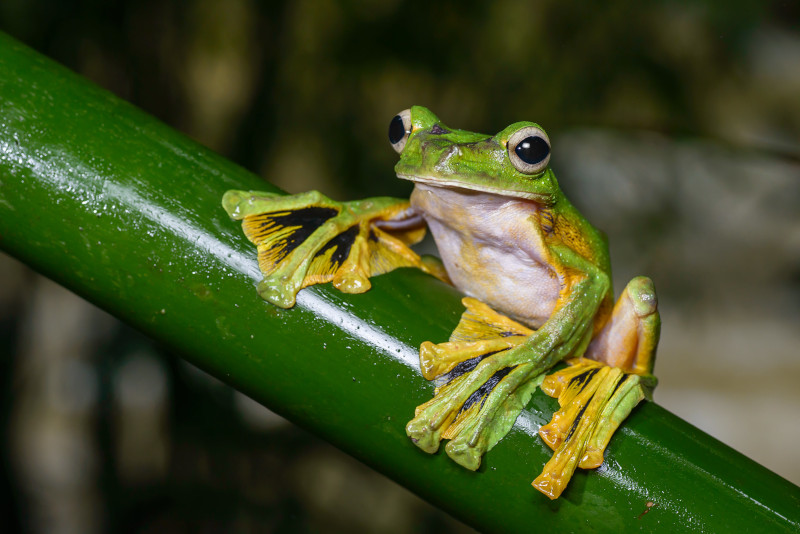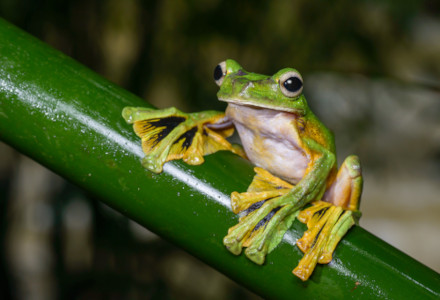
Wallace’s Flying Frog Facts
- The very name of the Wallace’s Flying Frog serves to indicate just how extraordinary it is. The common term derives partly from its unique ability, and also from the name of the individual that first discovered it. That was British biologist, Alfred R. Wallace.
- The generally used named for this miniature marvel of Nature remains much easier to remember than its scientific name, however. That tongue-twisting term, typically only used by professionals, is that of Rhacophorus nigropalmatus.
- Not surprisingly, the name’s somewhat misleading, since the animal does not actually fly. It does, however, glide short distances from tree to tree. Though not, again to one’s astonishment, the only known frog to possess this ability, it’s among the largest.
- The exact extent of the population of the Wallace’s Flying Frog continues to elude researchers. This occurs due to the fact that sightings happen infrequently. Experts also remain undecided as to whether this indicates a small population or not.
- For the moment, pending more information, the IUCN lists the remarkable and distinctive creature as Least Concern. This status, while subject to revision, presently appears on the organization’s Red List of Threatened Species.
- The fascinating animal nonetheless faces several clear threats to its continued existence. Ongoing habitat loss now represents an imminent danger to it. Its greatest peril, however, now comes in the form of the effects of escalating climate change.
Related Articles
Indian Bullfrog Wood Frog Mountain Chicken
Wallace’s Flying Frog Physical Description
The impressiveness of the aptly-named Wallace’s Flying Frog does not originate solely with its aerial abilities. Its size and appearance both also serve to merit interest in the wonder. In fact, it constitutes a slightly larger than average variety of frog.
The amazing amphibian further displays the physiological characteristic of sexual dimorphism, like many of its kin. In its specific case, this trait manifests itself in the fact that females, averaging 3.9 in (10 cm) in length, attain a slightly greater size than males.
Most people generally consider the Wallace’s Flying Frog to be highly photogenic, and rightfully so. The colors the animal presents typically include a bright green on the back. It also, however, usually displays either yellow or a pale white on the underside.
It also evolved over-sized webbed feet that it utilizes to glide from tree to tree. The eyes, meanwhile, grow quite large, and possess striking horizontal pupils. Not stopping there, the species also has large toe pads, which help it cling to trees as it lands from its flight.
- Kingdom: Animalia
- Phylum: Chordata
- Class: Amphibia
- Order: Anura
- Family: Rhacophoridae
- Genus: Rhacophorus
- Species: R. nigropalmatus
Wallace’s Flying Frog Distribution, Habitat, and Ecology
The remarkable Wallace’s Flying Frog, in fact, actually inhabits a moderately broad section of the world, at least when compared to related species. That habitat range, as it currently stands known, extends from the Malay Peninsula to western Indonesia, in Asia.
Within that somewhat extensive zone of habitation, though, it displays quite specific preferences for where it appears. To the knowledge of researchers, it only inhabits regions of rainforest, for starters. Even there, though, it specifically limits its range.
The amphibian does not seem to reside at altitudes of greater than 1,970 ft (600 m) above sea level. Yet another habitat requirement remains the local presence of either small pools of fresh water or slow-moving streams. These it requires for its evolved breeding habits.
The Wallace’s Flying Frog spends the majority of its life in the trees, descending only to mate and lay eggs. Its known diet, meanwhile, consists entirely of a variety of small insects. Finally, its only known natural predators seem to be various arboreal snakes.
Species Sharing Its Range
Komodo Dragon Kalanchoe North Sulawesi Babirusa
Check out our other articles on Incredible Sharks of the World, Golden-Handed Tamarin, Monkey Puzzle Tree, Fly Geyser, Mitchell’s Satyr Butterfly, Blue Shark

